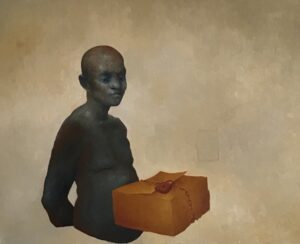THE UNDERWORLD: George Crump articulates a collective, yet intimate expression of his mind’s eye through a body of work that makes social statements regarding life experiences, both subjective and observational.
In his most recent body of work, Crump situates his conceptions of “the underworld” by way of the psychological and social afterlives of oppression, with a tone of the spiritual, often positioning his figures between reality and surrealism. Crump applies the principles of discipline, understanding, and compassion to his work through his specific use of color, rich narrative approach, and form.
“The source material of my work is the truth of my past and present life experiences”, Crump says.

George Crump. I Don’t Know. Oil on canvas. 24″x 20″.
Themes of remembrance and the spirit of determination traverse the scope of Crump’s work as he’s concerned with aspects of universal notions of existentialism, affliction, redemption, and triumph.
The exhibition opens for public viewing on January 14th and runs through March 26th. Please RSVP for our opening day here.
George Crump is a Chicago-based native and visual artist. He attended the School of the Art Institute of Chicago, and most recently held a solo exhibition at Faie African Art Gallery.
George developed his focus on the sensual nature of art, aiming to evoke universality and honesty within his practice. So much so, his strong emotional connection to his paintings are open to a variety of rich interpretations that span a wide range of emotions and forms.
RSVP for our timed viewing HERE.
COVID PROTOCOL
How to visit The Center safely:
– Vaccine verification required for entry
– Beginning January 3, in accordance with City of Chicago policy, all visitors 5 and older will be required to show proof of full vaccination.
– Please bring either your vaccine card, a printed copy, or a digital photo of your card.
– Visitors 16 and older will need to provide identification that matches their vaccination record
– Masks will continue to be required by all visitors 2 and older while in the museum.



